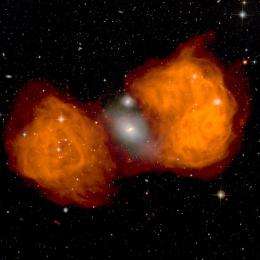Solving the mysteries of the plasma universe

What powers the most luminous sources in the universe? How is the plasma state altered by ultra-strong magnetic field? How do magnetic explosions work?
These are among 10 major questions for plasma astrophysics identified in the recently released Report of the Workshop on Opportunities in Plasma Astrophysics (WOPA). Plasma — the fourth state of matter — is a hot, electrically charged gas that makes up the Sun and other stars, and fuels the production of fusion energy.
"Plasma physics governs much of the behavior of the visible universe at all scales, from tokamaks to extra-galactic jets that are 10 billion times larger than the solar system," said Stewart Prager, Director of the U.S. Department of Energy's Princeton Plasma Physics Laboratory (PPPL). It is precisely this close relationship between tokamak physics and astrophysical phenomena that provided the motivation for the workshop and report. A tokamak is a type of magnetic fusion energy experiment.
PPPL scientist Hantao Ji said WOPA represents the first time for a comprehensive assessment of the opportunities in plasma astrophysics. Ji and Prager worked with a team to co-produce the report and were co-chairs of the workshop, held at PPPL earlier this year.
This grassroots effort brought together experimentalists, astronomers, and computational scientists to identify the major puzzles at this intersection of laboratory physics and space science, and to map out new strategies for better understanding the plasma universe. "It helped us identify opportunities for working together and will be a step toward expanding the field of plasma astrophysics and unifying this diverse new field," Ji said
Plasma astrophysics is the study of plasmas beyond the Earth's atmosphere, a discipline that is rapidly growing in scientific opportunity. This scientific fertility arises from the maturation of plasma theory, computation, and experimental techniques, combined with the surge in observational data.
Plasma astrophysics includes processes active in space, solar, and astrophysical plasmas. Often, a detailed understanding of the plasma physics under the specific space and astrophysical conditions holds the key to many long-standing mysteries. The practice of plasma astrophysics consists of diverse components: low energy density magnetized and unmagnetized basic plasma experiments, high energy density experiments, liquid metal experiments, analytic theory, fluid and kinetic computation, theoretical astrophysics, observations (space, solar, and astrophysical), and aspects of fusion energy experiments.
Prager said the research opportunities also would have impact in three areas beyond the 10 major questions. "Much of the physics overlaps with central challenges for fusion energy, both magnetic and inertial; the development of plasma physics targeted to astrophysics advances basic plasma physics; and plasma astrophysics is crucial to the guidance and interpretation of observational missions," he said.
WOPA participants were from universities, national laboratories, government research institutions, and private industry, including several scientists from outside the U.S.
More information: The report and more information about the workshop is at: www.pppl.gov/conferences/2010/WOPA/
Provided by Princeton Plasma Physics Laboratory
















